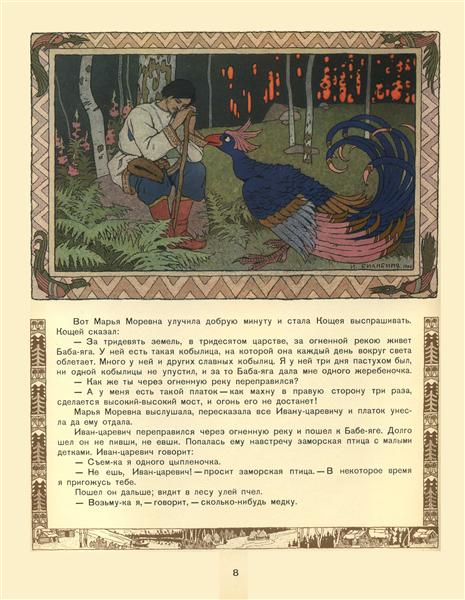Description
In the vast universe of Russian art, Iván Bilibin stands out as one of the most renowned illustrators of fairy tales, capturing magical precision the essence of folk narratives. His "illustration for the Russian fairy tale 'Maria Morevna'" (1900) is a masterful work that encapsulates the amalgam of tradition and aesthetics of the early twentieth century.
The canvas, with its meticulous detail and its vibrant color palette, immediately transports us to the mythical Russia of fairy tales. In the work we can observe an intricate composition where the figure of Maria Morevna, the central heroine of the story, highlights in the middle of an environment that mixes the real with the fantastic. Bilibin, in its custom of melt art and folk, uses a style that drinks directly from the sources of the Russian ornamental tradition, known as Lubok.
Maria Morevna's clothing, richly detailed, is a testimony of bilibin meticulousness. Geometric patterns and embroidery are almost palpable, and tell us about an era in which the costumes was also a status and cosmology communicator. The colors boldly contrasting ocher, gold and deep blue tones accentuate this royal quality further. These colors are not only chosen by their aesthetic attraction, but also by their symbology within the Slavic folklore.
In the central part of the composition, together with Maria Morevna, we can observe other figures that contribute to the narrative dynamism of the scene, possibly warriors or characters of relevance within the story. In the background, a castle and the suggestive figure of a storm stressed through the agitated stroke and the dark tones of the sky, add a sense of imminent conflict and suspense.
It is important to highlight that Bilibin was not only an illustrator but also a scholar of Russian folklore. His work is characterized by a cultural integrity that goes beyond the simple illustration; It is a visual interpretation informed by a deep understanding of popular legends and traditions. This precision is not only shown in iconography, but also in the narrative that chooses to count through its images.
The bilibin technique, which involves clean and defined lines, combined with a detailed ornamentation, almost reminiscent of medieval miniatures, creates a visual effect that is as complex as captivating. Each element seems to be in its precise place, inviting the viewer to get lost in the details and build their own interpretation of the story.
In the broader context of Russian art of the time, Bilibin is located at a crossroads between modernity and tradition. His work, although deeply traditional in content, presents a technical and conceptual sophistication that places it in parallel with contemporary European artistic tendencies, such as Art Nouveau, which clearly takes on their stylistic influences while adapting them to the Russian essence.
In summary, the "Illustration for the Russian fairy tale 'Maria Morevna'" by Iván Bilibin is more than a simple illustration; It is a window to a mythical world taken to life with artistic mastery and cultural devotion. In this work, Bilibin reaffirms its place not only as an illustrator, but as a true custodian of Russian narrative heritage, presenting it in a way that resonates both with the past and the present.
KUADROS ©, a famous paint on your wall.
Hand-made oil painting reproductions, with the quality of professional artists and the distinctive seal of KUADROS ©.
Art reproduction service with satisfaction guarantee. If you are not completely satisfied with the replica of your painting, we refund your money 100%.

